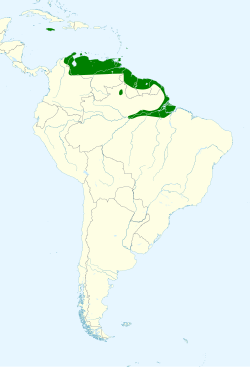Social
Green-rumped parrotlets are very gregarious and roost communally; [8] they are often seen in flocks of up to 100 individuals.
Green-rumped parrotlets make light, twittering calls. While in flocks, calls are louder and more penetrating. [8] Contact calls, similar to names, are individually distinct and are used for individual mate recognition. Each call varies in duration, frequency, and pitch. [14]
Green-rumped parrotlets have been observed in flocks consisting of combinations of breeding male-female pairs, nonbreeding male-female pairs, male-male pairs, and individual nonbreeding males; the number of each type depends on the season. Extra-pair copulation is relatively uncommon (less than 8% of young are conceived through extra-pair fertilization). [15]
Reproduction
Green-rumped parrotlets form strong pair bonds and rarely switch mates, but typically only breed with the same individual for 1–2 seasons. Widowed parrotlets will often take a new mate, and 48% of the new stepparents adopt the offspring. Stepfather parrotlets in particular nest with their new mates, attaining earlier ages at first breeding than competitors (stepmother-widower pair sample sizes were too small to produce results, at only 15 pairs). Therefore, adoption appears to be sexually selected. However, so is infanticide by stepfathers. [16]
Almost half of wild females attempt a second brood during their breeding season. [8] Green-rumped parrotlets breed during the rainy season (May–November), though each subspecies tends to breed during different months. They typically make their nests in unlined tree cavities, holes found in arboreal termite nests, or in cavities in wooden fence posts. Intense competition over limited nest sites has selected for marauding non-breeding pairs that attempt to usurp occupied nests and evict the abandoned offspring. [16]
The female lays 5–6 small white eggs over a period of 9–16 days. The female usually initiates incubation after the first egg is laid, leading to asynchronous hatching which begins 18–22 days after the start of incubation. Depending on the clutch size, hatching concludes 2–14 days after the first egg hatches. Fledging occurs 29–35 days after hatching, with the clutch fledging over a period of 14 days on average. [17]
The unusual length of the green-rumped parrotlet's nestling period is believed to be caused, or at least influenced, by the low levels of available nutrients and minerals for young found in typical green-rumped parrotlet habitat. [18] Because of the difference in hatching time, not all chicks are the same size when they are young. Research has been done on resource allocation between different chick sizes by green-rumped parrotlet parents. It was shown that male parents tend to feed larger chicks more often, while females are far more likely to feed smaller individuals first because of their begging habits - smaller chicks tend to beg more, while larger chicks are more submissive. This effect has also been observed in other parrot species. [19]
Research has shown that by planning asynchronous hatching, parent parrotlets don't have to spend as much time expending the high levels of energy associated with brooding, but the amount of energy expended does not change. [20]
It has been observed that over the course of mating and raising a brood of chicks, a female green-rumped parrotlet's mass varies greatly. Female individuals gained up to 25% more mass before laying and maintained this mass through incubation until hatching began. The amount of mass lost over the brooding and fledging periods was dependent on the size of the brood. It is believed that this mass change is caused by a combination of brooding starvation, adaptation to a new lifestyle, and sexual activity. [21]



